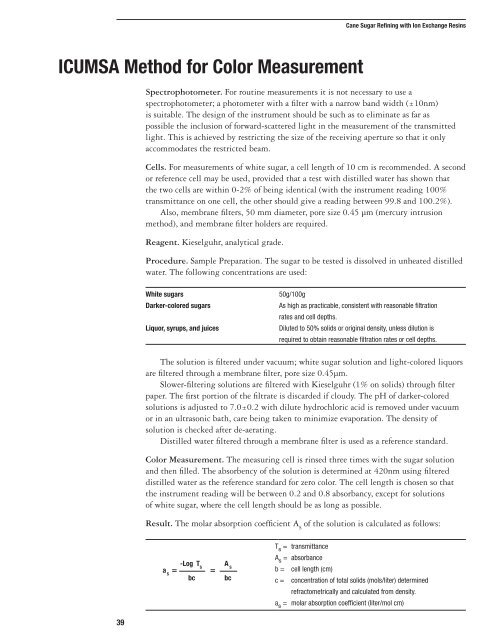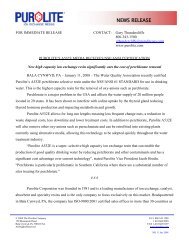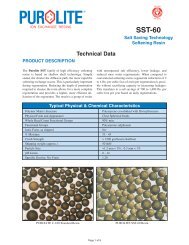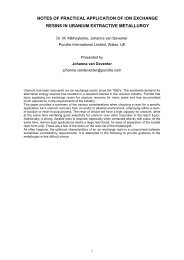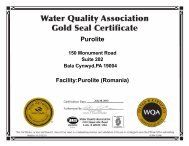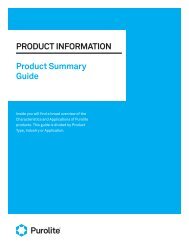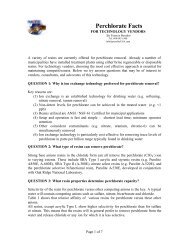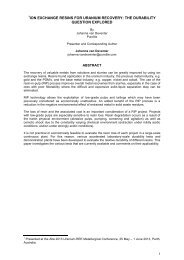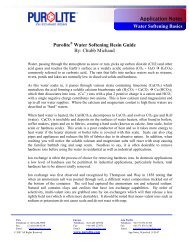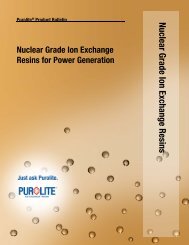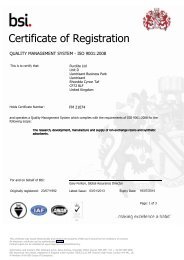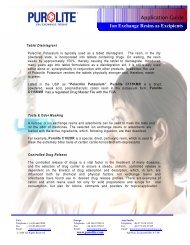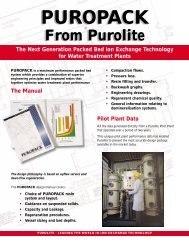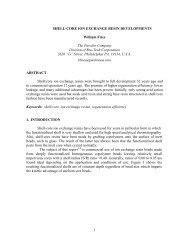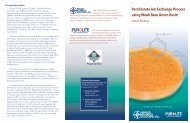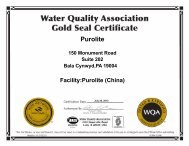Cane Sugar Refining - Purolite
Cane Sugar Refining - Purolite
Cane Sugar Refining - Purolite
Create successful ePaper yourself
Turn your PDF publications into a flip-book with our unique Google optimized e-Paper software.
ICUMSA Method for Color Measurement<br />
39<br />
<strong>Cane</strong> <strong>Sugar</strong> <strong>Refining</strong> with Ion Exchange Resins<br />
Spectrophotometer. For routine measurements it is not necessary to use a<br />
spectrophotometer; a photometer with a filter with a narrow band width (±10nm)<br />
is suitable. The design of the instrument should be such as to eliminate as far as<br />
possible the inclusion of forward-scattered light in the measurement of the transmitted<br />
light. This is achieved by restricting the size of the receiving aperture so that it only<br />
accommodates the restricted beam.<br />
Cells. For measurements of white sugar, a cell length of 10 cm is recommended. A second<br />
or reference cell may be used, provided that a test with distilled water has shown that<br />
the two cells are within 0-2% of being identical (with the instrument reading 100%<br />
transmittance on one cell, the other should give a reading between 99.8 and 100.2%).<br />
Also, membrane filters, 50 mm diameter, pore size 0.45 µm (mercury intrusion<br />
method), and membrane filter holders are required.<br />
Reagent. Kieselguhr, analytical grade.<br />
Procedure. Sample Preparation. The sugar to be tested is dissolved in unheated distilled<br />
water. The following concentrations are used:<br />
White sugars 50g/100g<br />
Darker-colored sugars As high as practicable, consistent with reasonable filtration<br />
rates and cell depths.<br />
Liquor, syrups, and juices Diluted to 50% solids or original density, unless dilution is<br />
required to obtain reasonable filtration rates or cell depths.<br />
The solution is filtered under vacuum; white sugar solution and light-colored liquors<br />
are filtered through a membrane filter, pore size 0.45µm.<br />
Slower-filtering solutions are filtered with Kieselguhr (1% on solids) through filter<br />
paper. The first portion of the filtrate is discarded if cloudy. The pH of darker-colored<br />
solutions is adjusted to 7.0±0.2 with dilute hydrochloric acid is removed under vacuum<br />
or in an ultrasonic bath, care being taken to minimize evaporation. The density of<br />
solution is checked after de-aerating.<br />
Distilled water filtered through a membrane filter is used as a reference standard.<br />
Color Measurement. The measuring cell is rinsed three times with the sugar solution<br />
and then filled. The absorbency of the solution is determined at 420nm using filtered<br />
distilled water as the reference standard for zero color. The cell length is chosen so that<br />
the instrument reading will be between 0.2 and 0.8 absorbancy, except for solutions<br />
of white sugar, where the cell length should be as long as possible.<br />
Result. The molar absorption coefficient A S of the solution is calculated as follows:<br />
a S<br />
-Log T S<br />
bc<br />
A S<br />
bc<br />
T S = transmittance<br />
A S = absorbance<br />
b = cell length (cm)<br />
c = concentration of total solids (mols/liter) determined<br />
refractometrically and calculated from density.<br />
a S = molar absorption coefficient (liter/mol cm)


